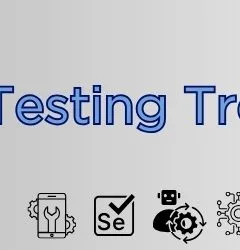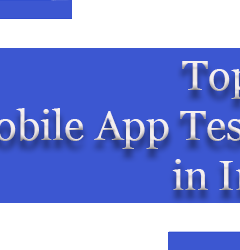01 Jan

Why Android?
Android is king in the constantly changing mobile market. It should come as no surprise that testers and developers alike choose this stable platform given its incredible 71% market share in India alone.
But to guarantee a seamless user experience, creating an ideal Android app requires more than just writing code. This is when reliable companions in the pursuit of quality assurance, Android Testing frameworks, come into action. the open-source nature of Android, its large user base, and its abundance of customization options present both opportunities and challenges. To ensure that applications function properly on every type of device, screen size, and OS version, robust testing methodologies and frameworks are necessary.
Top 7 Frameworks for Android Testing in Action
Let’s now analyze the top 7 Android testing frameworks that will provide you with everything you need for 2024 success.
Espresso:
Espresso, the official framework from Google, is known for its reliability, speed, and easy Android Studio integration. It is ideal for testing user Interface and user experience and validating screen elements because it excels at user interface testing.
Espresso is still a favorite among developers because of how easy and efficient it is to use for testing Android user interfaces. Espresso, a feature of the Android Testing Support Library, makes it easier for developers to write understandable and succinct test scripts by enabling UI testing that is both dependable and condensed. It is a preferred framework for UI testing because of its synchronization features and user-friendly APIs, which facilitate effective testing of app interactions.
Appium:
An excellent tool for testing native, online, and hybrid Android apps, Appium is a real all-rounder. You can develop tests in a variety of computer languages, including Java, Python, and JavaScript, thanks to its excellent automation features.
Appium provides cross-platform support for mobile application testing as an open-source automation tool. Testers can create tests with Appium using their favorite programming languages and frameworks thanks to its “write once, run anywhere” functionality. App testing across various Android versions and devices is made easier with its support for both native and hybrid apps.
Robotium:
For UI testing and black-box testing, this lightweight framework works. It’s perfect for beginners and quick evaluations because of its straightforward API and minimal setup.
Testers can create strong, automatic black-box user interface tests with it, which span a variety of scenarios such as system apps and various Android activities. One reason Robotium is so well-liked by developers is that it supports hybrid apps and has simple APIs.
Selendroid:
This web-driver-based framework also easily simulates pinch, swipe, and tap user actions. It is a useful tool for testing legacy apps because it is compatible with earlier versions of Android.
specifically created for Android applications, Selendroid is a robust web-driver-based testing framework. Its ability to accurately replicate real-user interactions by simulating different user movements like pinch, swipe, and tap is what sets Selendroid apart from other similar apps. Testing the operation and responsiveness of Android apps on various devices and screen sizes is made much easier with this option.
Calabash:
Calabash is your friend if you enjoy the syntax of Gherkin and Cucumber. You can write tests in plain English using this behavior-driven testing (BDT) paradigm, which makes them understandable to stakeholders who aren’t technical.
It is a good option for teams that work on multiple platforms because of its cross-platform connectivity and support for both iOS and Android. Because of its simple syntax, Calabash makes it easier for developers and testers to work together to create test suites that are both clear and maintainable.
MonkeyRunner:
The Unpredictable Powerhouse for Android Testing. Although not receiving upgrades from Google, MonkeyRunner is still an effective tool for app stability research and stress testing. Under unforeseen circumstances, its capacity to produce random events and mimic user behavior can uncover hidden faults.
Stress Testing Simplified
Imagine throwing everything at your app, including forceful scrolling sessions, quick button hits, and even inadvertent key mashing. That’s exactly what MonkeyRunner does—it emulates high user traffic and pushes the boundaries of your software to the maximum. Through stress testing, performance bottlenecks and potential crashes under high usage situations are found.
Firebase Test Lab:
Providing a flawless Android experience is crucial in the quick-paced world of app development. It may be quite challenging, though, to make sure your software functions correctly on a variety of devices and setups. Welcome to Firebase Test Lab, your portal to an ideal cloud-based environment for thorough and effective Android testing.
It makes it possible for developers to thoroughly evaluate their apps for usability, performance, and compatibility with a wide range of genuine Android devices hosted in the cloud. Its incorporation with additional Firebase services expedites the Android app testing and deployment procedure.
Conclusion:
Follow the most recent developments in frameworks and trends. With the mobile development industry changing at a rapid pace, it’s important to stay up to date on the latest developments in Android testing to guarantee your skills stay applicable.
As we move further into 2024, these frameworks are set to continue shaping the landscape of Android app testing, helping developers navigate the complexities of creating top-notch applications for the ever-expanding Android ecosystem.
Akshay works as a Manual QA tester at QACraft. He is a Computer Engineer with a degree and has 6+ months of experience in manual testing etc. In his free time, he loves to explore his knowledge of QA and also loves photography and traveling.
Related Post
Recent Posts
Categories
- Agile Testing
- Android App Testing
- Automation Testing
- Banking Domain Testing
- Beta Testing
- cloud testing
- Corporate Life
- cross browser testing
- Cypress Testing
- desktop testing
- Domain Testing
- E-commerce Website Testing
- E-learning App Testing
- Functional Testing
- Game Testing
- Healthcare Domain Testing
- Infographics
- Ios App Testing
- Jenkins
- JIRA
- Katalon
- Manual Testing
- Mobile App Testing
- monkey testing
- Performance Testing
- Salesforce Testing
- security testing
- Selenium
- Software Testing
- static testing
- Test Environments
- vdfv
- Web Application Testing
© Copyright 2024 QACraft Pvt. Ltd. All rights reserved.
Contact : +91 9157786796



akshay